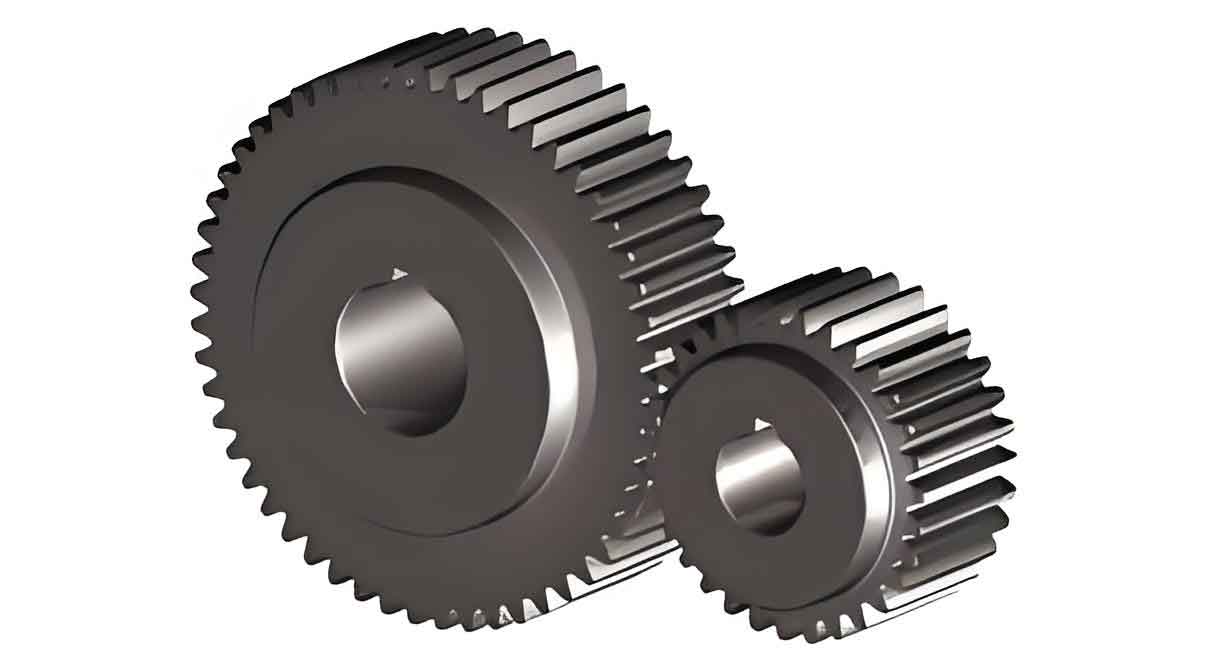1. Introduction
Spur gear is widely used in mechanical transmission systems due to their simplicity, high efficiency, and precise transmission ratios. However, their inherent structural characteristics—such as time-varying mesh stiffness caused by alternating single- and double-tooth engagement—often lead to significant vibration and noise. These issues are exacerbated by manufacturing inaccuracies, assembly errors, and wear over time. While improving gear precision can mitigate noise, it is often economically impractical. Passive noise control methods, particularly those utilizing viscoelastic materials, have emerged as cost-effective solutions.
This study focuses on reducing spur gear noise by applying viscoelastic polymers (acrylic ester and polyurethane) to gear end faces. We explore how material type and coating thickness influence noise suppression, providing insights for industrial applications.

2. Mechanism of Noise Reduction Using Viscoelastic Materials
Viscoelastic materials dissipate vibrational energy through molecular chain interactions. When subjected to external forces, these materials exhibit hysteresis (Figure 1), where energy is absorbed as heat during deformation and recovery cycles. The energy loss per unit volume can be modeled as:ΔP=βρ(A0e−αz)2ΔP=βρ(A0e−αz)2
where:
- ββ: Attenuation coefficient of the material
- ρρ: Material density
- A0A0: Initial noise amplitude at z=0z=0
- αα: Absorption coefficient
The loss coefficient κκ is proportional to material thickness (δzδz) and ββ:κ=2βδzκ=2βδz
This relationship indicates that noise reduction improves with increased coating thickness, up to a saturation point.
3. Experimental Setup
3.1 Spur Gear Parameters
The spur gear pair used in experiments had the following specifications:
| Parameter | Value |
|---|---|
| Driving gear teeth (z1z1) | 30 |
| Driven gear teeth (z2z2) | 20 |
| Module (mm) | 3 mm |
| Pressure angle (αα) | 20° |
| Center distance (LL) | 75 mm |
| Face width (bb) | 28 mm |
3.2 Test Bench Configuration
The experimental setup included:
- A 1.5 kW DC motor with PWM speed control.
- Optical sensors for real-time vibration monitoring.
- Microphones for noise acquisition (sampling rate: 44.1 kHz).
- A gear pair with non-uniform wear to simulate real-world conditions.
Viscoelastic materials were uniformly applied to both end faces of the spur gear. Testing was conducted at speeds ranging from 120 to 720 rpm, with a focus on 720 rpm (fmesh=360 Hzfmesh=360Hz) to avoid excessive noise (>100 dB).
4. Results and Discussion
4.1 Noise Reduction Performance by Material Type
Table 1 compares the noise reduction efficiency of acrylic ester and polyurethane at different thicknesses.
| Material | Thickness (mm) | Avg. Noise Reduction (dB) | Dominant Frequency Range |
|---|---|---|---|
| Polyurethane | 0.4 | 4.2 | 200–2500 Hz |
| Acrylic Ester | 0.6 | 8.5 | 200–2500 Hz |
| Acrylic Ester | 0.93 | 12.1 | 20–2500 Hz |
| Acrylic Ester | 1.93 | 14.3 | 20–2500 Hz |
Key observations:
- Acrylic ester outperformed polyurethane, achieving nearly double the noise reduction at similar thicknesses.
- Low-frequency noise (20–200 Hz) required thicker coatings (>0.93 mm) for effective suppression.
4.2 Frequency-Dependent Noise Absorption
The spur gear noise spectrum (Figure 5) revealed prominent peaks at:
- Rotational frequency harmonics: 6f6f, 7f7f, 13f13f
- Mesh frequency harmonics: fmeshfmesh, 2fmesh2fmesh
Table 2 summarizes the sound pressure level (SPL) reduction at critical frequencies.
| Frequency (Hz) | SPL Reduction (dB) |
|---|---|
| 72 (6f6f) | 5.8 |
| 360 (fmeshfmesh) | 12.4 |
| 720 (2fmesh2fmesh) | 9.7 |
| 1440 (4fmesh4fmesh) | 3.2 |
Thicker acrylic ester coatings (>1 mm) significantly attenuated low-frequency noise, aligning with theoretical predictions. However, high-frequency noise (e.g., 1440 Hz) showed limited improvement due to modulation effects.
4.3 Impact of Coating Thickness
The relationship between coating thickness and noise reduction followed a logarithmic trend (Figure 7):Noise Reduction=κln(δz)+CNoise Reduction=κln(δz)+C
where CC is a material-dependent constant. Beyond 1.93 mm, diminishing returns were observed due to adhesion issues between acrylic ester and the spur gear surface.
5. Conclusion
- Material Selection: Acrylic ester demonstrated superior noise reduction capabilities compared to polyurethane, particularly at thicknesses >0.6 mm.
- Thickness Optimization: A coating thickness of 0.93–1.93 mm provided optimal noise suppression across a broad frequency range (20–2500 Hz).
- Practical Limitations: Adhesion strength between the material and spur gear surfaces limited the effectiveness of ultra-thick coatings.
This study validates the practicality of viscoelastic materials for spur gear noise control. Future work should explore hybrid materials and advanced surface treatments to enhance adhesion and durability.
